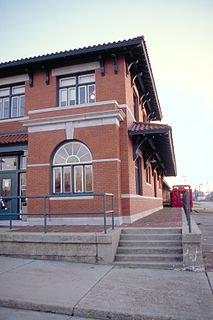
The Delta Cultural Center in downtown Helena, Arkansas, is a cultural center and museum of the Department of Arkansas Heritage. It is dedicated to preserving and interpreting the culture of the Arkansas Delta.
Mitchell House may refer to:
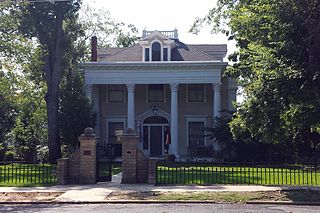
The William H. Martin House is a historic house at 815 Quapaw Avenue in Hot Springs, Arkansas, USA. It was designed by the architect Frank W. Gibb in 1904 and built in the same year. It includes Colonial Revival and Classical Revival architectural elements. It is an imposing building with a two-story Greek temple portico supported by four fluted Corinthian style pillars. The portico's cornice is modillioned with scrolled brackets, and has a band of dentil molding. When built, the house was on the outskirts of Hot Springs.

The Lane Hotel is a historic former hotel building in Rogers, Arkansas, United States. It is a five-story yellow brick Spanish Revival building, designed by architect John Parks Almand and completed in 1929. It is the largest Spanish Revival building in Arkansas, with a prominent colonnade of arches at the second level, above a first floor series of commercial storefronts, and a central tower. The hotel was not successful, having been completed just at the outset of the Great Depression, and went through a succession of owners before closing in 1965. Beginning in 1999 it was a retirement community known as Peachtree on the Lane

The Randolph James House is a historic house at 1212 North Madison Avenue in El Dorado, Arkansas. The two-story stuccoed house was designed by Mann & Stern, and was built in 1927 for Randolph James by his father George, a principal in the local Exchange Bank who benefited from the city's oil boom in the 1920s. The house is a fine local example of Spanish Mission Revival styling, with wrought iron balconies, tile roof, stucco walls, and varied windows.

The Murphy–Hill Historic District encompasses the oldest residential portion of the city of El Dorado, Arkansas. It is located just north of the central business district, bounded on the north by East 5th Street, on the west by North Jefferson and North Jackson Avenues, on the east by North Madison Avenue, and on the south by East Peach and East Oak Streets. Six of the 76 houses in the 40-acre (16 ha) district were built before 1900, including the John Newton House, one of the first buildings to be built in El Dorado. Of particular note from this early period is a highly elaborate Queen Anne Victorian at 326 Church Street.

The Washington Street Historic District of Camden, Arkansas, encompasses an area that has been a fashionable residential area for much of the city's history. It includes six blocks of Washington Street, three of Graham Street, and three connecting streets. The oldest houses in this area are pre-Civil War Greek Revival houses, built in the 1840s and 1850s when Camden was at its height as a major regional center of the cotton trade. Another round of development took place late in the 19th century after the railroad arrived, resulting in a number of Queen Anne, Colonial Revival, and Classical Revival houses. The last major building spurt took place during southern Arkansas' oil boom in the 1920s and 1930s, when Mission/Spanish Revival, Mediterranean, and English Revival houses were built. The district included 68 contributing properties when it was first listed on the National Register of Historic Places in 2010. Six structures were previously listed separately on the National Register. The district was enlarged in 2018.

The June Sandidge House is a historic house at 811 Cherry Street in Gurdon, Arkansas. It is a single-story wood-frame house with a brick veneer exterior, and represents an excellent and unusual local example of English Revival architecture. The house was built in 1938 by Mr. June Sandidge, an engineer for the Missouri Pacific Railroad. Its styling is essentially vernacular English Revival, although there are some Mediterranean influences, including Spanish-style arches on the porch.

The East Hamilton Avenue Historic District encompasses a 20th-century residential area of Wynne, Arkansas, reflective of its growth between about 1920 and 1940. It extends along East Hamilton Avenue, between North Falls Boulevard and Killough Road, and includes properties on Eldridge Court. East Hamilton Avenue, representing the best-preserved area of development from this period, was developed gradually beginning in the late 19th century, and grew from west to east. The oldest house in the district, the Giboney-Robertson-Stewart House, is a Queen Anne Victorian built c. 1895. Most of the houses were built after 1920, and are predominantly Craftsman, Colonial Revival, and Tudor Revival in character. There are a few Spanish (Mediterranean) Revival houses, and a few early ranch houses, which were generally built between 1940 and 1950.
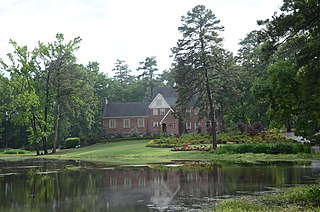
The Bellingrath House is a historic house at 7520 Dollarway Road in White Hall, Arkansas. It is a large 2-1/2 story masonry structure, built out of brick, stone, and half-timbered stucco in the Tudor Revival style. Its basically rectangular form is augmented by rectangular projecting sections and gabled elements of varying sizes. It has four chimneys, some brick and some fieldstone, and windows in a variety of configurations and sizes. One of the most notable features of the house is a massive fireplace built of rubble stone at the southern end of the house.
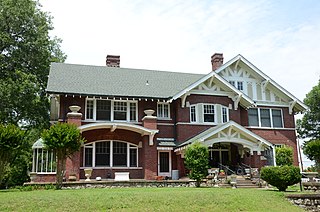
The Carnahan House is a historic house at 1200 South Laurel Street in Pine Bluff, Arkansas. Built in 1919, it is a high-quality example of Craftsman and Tudor Revival styling, designed by Mitchell Seligman, a prolific local architect. It is a 2 1⁄2-story brick structure, with a side gable roof and a front-facing cross gable with half-timber stucco. The property includes a garage and guesthouse, also designed by Seligman.

The Hanger Hill Historic District encompasses a collection of early 20th-century residential properties on the 1500 block of Welch Street in Little Rock, Arkansas. Included are nine historic houses and one carriage barn, the latter a remnant of a property whose main house was destroyed by fire in 1984. The houses are all either Colonial Revival or Queen Anne Victorian, or share some stylistic elements of both architectural styles, and were built between 1906 and 1912. Six of the houses are distinctive in their execution of these styles using rusticated concrete blocks.

The Harris House is a historic house at 6507 Fourche Dam Pike in Little Rock, Arkansas. It is a single-story stuccoed structure, designed in an ecelctic interpretation of Spanish Revival architecture. Prominent features include a circular tower at one corner, a parapet obscuring its sloping flat roof, and a port-cochere with a segmented-arch opening supported by battered wooden columns. It was built in 1924 for Florence and Porter Field Harris, to their design and probably the work of Porter Harris, a master plasterer known for his work on the Arkansas State Capitol.

The Mayfair Hotel is a historic building at Spring and Center Streets in Searcy, Arkansas. It is an L-shaped two story brick building, with Spanish Revival styling. It has a hip roof with stepped wall dormers and exposed rafter ends in the eaves, and a corner tower with a similar stepped parapet. Built in 1924, it is the only historically non-residential Spanish Revival building in White County. It has been converted into a multiunit apartment house.
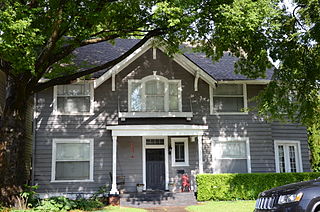
The Mitchell House is a historic house at 1415 Spring Street in Little Rock, Arkansas. It is a two-story frame structure with Colonial Revival and Craftsman features, designed by Charles L. Thompson and built in 1911. It has a three-bay facade, with wide sash windows flanking a center entrance and Palladian window. The center bay is topped by a gable that has large Craftsman-style brackets. A porch shelters the entrance, which is topped by a four-light transom window, and has a small fixed-pane window to its right.

The James Mitchell School is a historic school building at 2410 South Battery Street in Little Rock, Arkansas. The oldest portion of the building is a four-room structure designed by Charles L. Thompson and built in 1908. It was enlarged several times, notably by Thompson in 1910, and Thomas Harding, Jr. in 1915, and 1952. Harding's addition gave the building its prominent Classical Revival entrance portico. The school property includes two outbuildings that also houses classrooms. The school was originally a segregated facility, serving only white students, but the end of segregation transformed the school into one that served its predominantly black neighborhood. It was closed in 2005.
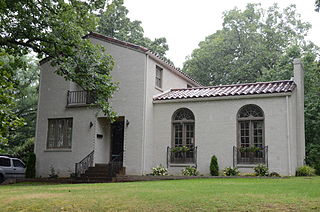
The Owings House is a historic house at 563 Skyline Drive in North Little Rock, Arkansas. It is a two-story brick building, with classic Spanish Revival features, including a tile roof, arched openings, and iron grillwork. It is unusual in that its brick has not been stuccoed. The house was built in 1927 by Justin Matthews as part of his large Edgemont development. It was the first house to be completed, and was lost by its owners to foreclosure during the Great Depression.

The Safferstone House is a historic house at 2205 Arch Street in Little Rock, Arkansas. It is a two-story stuccoed building, with a gabled terra cotta roof. A single-story gabled porch extends to the front across the left half, with a rounded archway in the front. A recessed ell extends to the right of the main block, and a shed-roof bay projects to the left. The house was built in 1925 and designed by Sanders and Ginocchio (Cromwell), and is an example of Spanish Mission Revival architecture.

The Fred and Lucy Alexander Schaer House is a historic house at 13219 United States Route 70, a short way east of Galloway, Arkansas. It is a two-story frame structure, with a gabled tile roof and brick veneer exterior. Built about 1920, it is a fine example of Mission/Spanish Revival architecture, with the tile roof, brick exterior, and decorative ironwork elements all hallmarks of the style. The house's design has been attributed to both John Parks Almand or Charles L. Thompson, who did work for other members of the Schaer family.




















